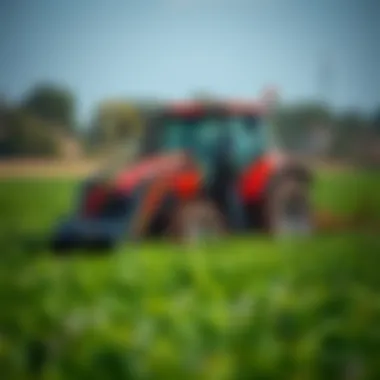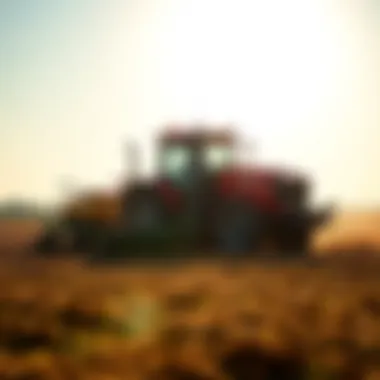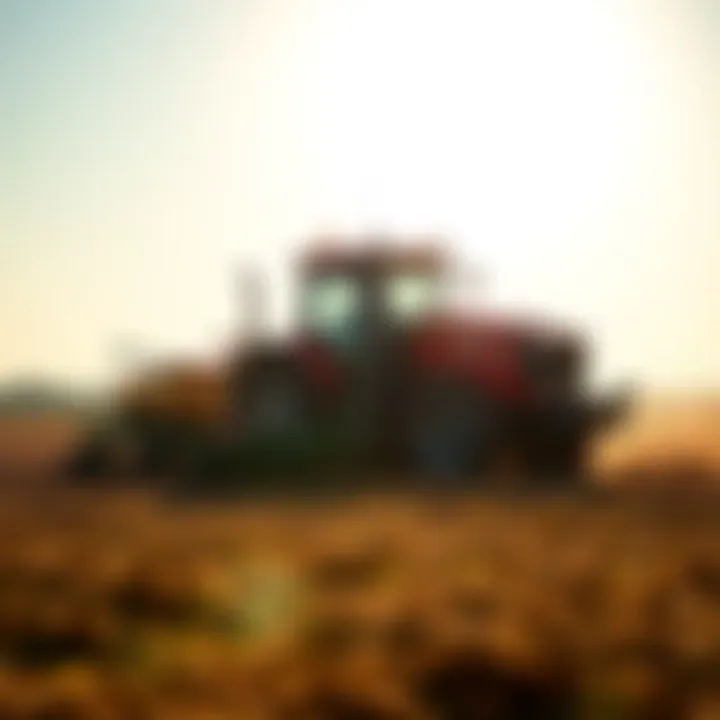Tractors for Effective Mowing and Plowing


Intro
In the realm of agriculture and land management, tractors have stood as bastions of efficiency and capability. With their ability to tackle a multitude of tasks—from mowing lush pastures to plowing fertile fields—tractors are foundational to modern farming practices. In this guide, we will examine not only the functions of tractors in mowing and plowing but delve deeper into their pivotal role in sustainable agriculture and the technologies shaping their future.
Understanding the various tractor types and their applications is crucial for both seasoned professionals and budding enthusiasts alike. This exploration serves to inform readers about the nuances of selecting the right equipment, ensuring that each task, be it mowing or plowing, is executed with precision and effectiveness. Moreover, as the agricultural industry transitions toward sustainability, embracing eco-friendly practices and innovative technologies becomes ever more essential. We'll also take a closer look at practical applications and tools that can elevate farming practices to new heights, giving you the insights you need to optimize your land management efforts.
Throughout the following sections, we'll present compelling case studies, contemporary practices, and essential resources. By the end of this journey, you will walk away with a robust understanding of not only tractors but also how they integrate into a holistic approach to agriculture.
Understanding Tractors
When delving into the world of agriculture, the importance of understanding tractors cannot be overstated. These machines serve as the backbone of modern farming, enabling efficiency that was unthinkable just a few decades ago. Grasping the intricacies of tractors helps farmers and enthusiasts select the appropriate equipment for their specific tasks, be it mowing vast fields or plowing through tough soil. This section will provide a clear understanding of what makes tractors vital in today’s agricultural ecosystem.
Definition and Purpose
Tractors are versatile, powerful machines designed primarily for agricultural tasks. They are engineered to pull or push various implements, making them essential for operations like plowing, planting, and of course, mowing. The core purpose of a tractor lies in its ability to enhance productivity, minimizing manual labor. By harnessing the strength of tractors, farmers can cover more ground in less time, making it easier to manage larger plots of land. In essence, tractors are the workhorses of the farm, transforming labor-intensive tasks into manageable actions.
Historical Evolution
Tractors have come a long way since their inception in the late 19th century. The first steam-powered tractors, heavy and cumbersome, laid the groundwork for future innovations. As technology progressed, internal combustion engines were integrated, ushering in an era of more mobile and efficient machines. The post-war years saw the rise of modern tractors, equipped with features that offered better horsepower and versatility. Every decade has brought about advancements, from hydraulic systems to modern GPS technology, enhancing the functionality and precision of tractors. Understanding this evolution is critical for recognizing how these machines have shaped current farming practices and how they continue to evolve.
Types of Tractors
Tractors come in various shapes and sizes, each suited for specific tasks. Understanding the types of tractors can significantly improve decision-making processes when it comes to purchasing or renting farm equipment. Four main categories stand out:
Utility Tractors
Utility tractors are the Swiss army knives of the tractor family. Their adaptability makes them a popular choice for farmers dealing with diverse tasks. Typically characterized by their mid-range horsepower, they can perform a range of functions from mowing to towing. One of their standout attributes is the ability to fit a variety of attachments such as loaders and backhoes, making them exceptionally versatile. However, they might not be ideal for large-scale plowing tasks due to their limited power compared to larger models.
Compact Tractors
Compact tractors are all about efficiency in smaller spaces. These machines combine agility with good horsepower, making them ideal for both residential gardens and small farms. Their lighter build allows for minimal soil compaction, which is beneficial for sensitive crops. Given their size, they can navigate tight turns and small areas effectively, a huge plus for those who have limited space. Yet, it should be noted that their horsepower limitations might restrict some heavy-duty applications.
Garden Tractors
Garden tractors are designed with residential lawns in mind, providing a blend of power and convenience for homeowners. These smaller variants shine in mowing and maintaining gardens, but they often come with attachments like trailers and dethatchers which make them multifunctional. The main advantage of garden tractors lies in their ease of use and storage, however, they are less suited for extensive agricultural tasks due to their lower horsepower and durability.
Specialty Tractors
Specialty tractors cater to niche agricultural needs. This category includes tractors specifically built for vineyards, orchards, and specialized farming conditions. Their low-profile design and unique features, such as narrow tires or specific steering systems, enable them to operate effectively in unique environments. The distinctiveness of specialty tractors makes them a necessary investment for farmers dealing with specialty crops, although they might lack versatility for general-purpose use.
Understanding these different types of tractors allows farmers to choose the right model suited for their specific operations. It enhances the possibility of achieving optimal performance while ensuring that the selected machinery aligns with the agricultural goals at hand.
Tractors for Mowing
Mowing isn’t just a chore; it’s a vital task in maintaining a productive landscape. Tractors designed for mowing play a significant role in various agricultural practices, as well as in residential lawn care. They are designed to handle diverse terrains and grass types, ensuring that users achieve clean, efficient results.
The importance of tractors for mowing can't be overstated. These machines not only save time but also allow operators to tackle large areas with ease compared to manual mowers. With specialized attachments, such as rotary, flail, and reel mowers, tractors can adapt to different mowing needs, whether clearing overgrown fields or keeping a suburban lawn tidy.
Mowing Techniques and Technologies
Utilizing the right mowing techniques and advanced technologies can greatly enhance the mowing process. Many modern mowers now come equipped with features that allow for precise cutting, which reduces the chances of damaging the grass. Leveraging such technologies means improved efficiency while ensuring a beautifully manicured landscape.
Furthermore, GPS-assisted navigation systems are becoming commonplace in mowing tractors, offering a level of accuracy that manual methods simply can’t match. If you ever found yourself going over the same patch of grass twice or leaving behind missed spots, these technologies can be a game changer.
Choosing the Right Mower Attachments
Picking the right mower attachment is crucial, as it can significantly affect your mowing experience. Here’s a closer look at three common types:
Rotary Mowers
Rotary mowers are renowned for their versatility. They utilize a horizontal rotating blade beneath the mower deck that can swiftly cut through grass, making them suitable for taller grass and thicker vegetation. Their ability to handle a variety of grass types and densities makes them a popular choice among farmers and landscapers alike.
The major characteristic of rotary mowers is their power and adaptability. They can tackle rough patches without much fuss. However, one potential downside is that they can leave a less precise cut compared to other mower types, especially when dealing with delicate grasses.
Flail Mowers


Flail mowers stand out with their sturdy construction and ability to handle heavy-duty tasks. They utilize multiple blades attached to a rotating shaft, which cuts and shreds more than just grass, making them suitable for brush and in tougher conditions.
Their key characteristic is robust build quality along with efficiency in managing thicker underbrush and tougher terrain. While this makes them a beneficial choice for large-scale mowing jobs, it’s worth noting that they can be slower compared to rotary mowers, which might not vibe well with everyone.
Reel Mowers
Now, if you’re looking for precision cutting, reel mowers have you covered. These mowers use a series of blades that rotate to shear grass, providing a clean and even cut. This method promotes healthy grass growth, making it a favorite among lawn enthusiasts who want to maintain a pristine appearance.
What sets reel mowers apart is their eco-friendliness—no gasoline or electricity needed; just a good old push. However, they might not be as effective on thicker grass or tougher terrains, and that’s where personal preference comes into play.
Operational Considerations
Mowing isn’t merely about hopping on a tractor and cutting grass. Various operational considerations can affect mowing quality and effectiveness.
Ground Conditions
Ground conditions are a significant factor that can impact mowing. Uneven or rocky terrain can damage both the mower and the tractor, leading to costly repairs. Ensuring the ground is adequately prepared before mowing can save time and prevent accidents.
Ground conditions affect the choice of mower, too. For instance, rough terrain might be better suited for tougher machines, while smoother, well-maintained ground allows for lighter attachments. Keeping this in mind is crucial for effective mowing.
Mower Maintenance
Like any piece of machinery, regular maintenance is essential for mowers to perform efficiently over time. This includes sharpening blades, checking belts, and even cleaning the mower deck to avoid grass buildup. A well-maintained mower works more efficiently and produces better mowing results.
Regular mower maintenance helps prolong the life of your equipment, ensuring it runs well season after season. Failing to maintain it, on the other hand, could lead to decreased performance and potential breakdowns.
Safety Protocols
No discussion on mowing would be complete without addressing safety protocols. Operating a tractor with a mower attachment poses certain risks, and it’s essential to adhere to safety guidelines. This includes wearing appropriate safety gear, being aware of your surroundings, and ensuring proper operation of the machinery.
Establishing safety protocols minimizes risks of accidents and injuries while mowing, making it an indispensable part of the operational process. Remember, a safe operator is an effective operator.
Tractors for Plowing
When it comes to farming, understanding the nuance behind plowing can make all the difference. Plowing is more than just a superficial act of turning over soil; it's a fundamental practice that influences crop yield, soil health, and overall sustainability in agriculture. A tractor designed for plowing offers the muscle and precision needed to prepare land efficiently. This section will examine the importance, types, and associated soil conditions related to plowing, emphasizing why the right equipment is crucial in modern farming.
The Importance of Plowing
Plowing serves multiple purposes that resonate deeply in the agricultural cycle. First off, it aids in breaking up compacted soil, creating a softer germination bed for seeds. Moreover, it helps in controlling weeds, which can otherwise choke new growth and compete for essential resources. By turning under the previous crop’s residue, plowing also contributes to soil fertility as organic matter decomposes and enriches the earth.
It's like giving the soil a breath of fresh air, revitalizing it for the new planting season. The act of plowing prepares the canvas for crops, setting the stage for a successful harvest. Without proper tillage, fields can rapidly transition from flourishing gardens to barren wastelands.
Plow Types and Their Applications
Different types of plows cater to varied soil types and farming needs. Each has its distinct advantages, making it vital to choose wisely based on your agricultural goals.
Moldboard Plow
The Moldboard Plow is a classic tool that has stood the test of time, known for its efficiency in turning and aerating the soil. One defining feature of this plow is its curved blade, which slices through the earth, lifting and flipping the soil in a single motion. This is especially beneficial when dealing with heavy-residue areas; it buries debris effectively, paving the way for cleaner fields.
However, there can be downsides. Overuse of the Moldboard Plow may lead to soil erosion and compaction in the long run if not managed properly. Thus, farmers must employ it judiciously to maintain soil integrity.
Chisel Plow
On the other hand, a Chisel Plow offers a more delicate approach to soil management. Instead of turning the soil completely, it breaks up compacted layers while keeping some of the residue on top. This feature is particularly helpful in conservation tillage, where minimizing soil disturbance is crucial for preserving moisture and organic matter.
While it's a great option for some soils, a Chisel Plow may not break up dense or clay-heavy areas as effectively as a Moldboard Plow. Thus, its application can be highly dependent on the specific conditions of the land.
Disc Plow
The Disc Plow is another notable option, equipped with a series of round blades. It excels in various conditions, particularly in hard soils and areas with significant organic matter. Its strength lies in its ability to cut through tough soil, making it a go-to choice for breaking virgin land or heavily packed ground. However, its unique design may lead to uneven soil disturbance if not operated correctly.
Farming enthusiasts should weigh these factors carefully while selecting a plow type. Researching both advantages and disadvantages can prevent unexpected outcomes during the plowing season.
Understanding Soil Conditions
Grasping the intricacies of soil conditions is vital when planning for plowing. Ignoring these conditions could spell disaster for crop health.


Soil Composition
Soil composition comprises various elements, including sand, silt, and clay, each playing a pivotal role in water retention and drainage. Knowing your soil's makeup helps in choosing the right plow and technique. If the soil is too sandy, it may not hold nutrients well, while clay-heavy soil requires a different approach. Farmers can take advantage of soil tests to determine functionality.
Moisture Content
Understanding moisture levels in the soil can significantly influence your plowing strategy. Soil that is too wet can lead to clumping, while arid conditions hinder plowing entirely. This delicate balance can dictate when to hit the fields or wait it out. Keeping an eye on the water content can ensure easier plowing and healthier crops.
Crop Rotation Effects
The impact of crop rotation should not be underestimated. Switching up crops can result in better soil health, as different plants access nutrients differently. Additionally, the residues from previous crops may affect the subsequent plowing process. Familiarity with how each crop interacts with the soil will guide effective and sustainable farming practices.
"Understanding the earth beneath our feet is as vital as the seed we plant; it holds the promise of our harvest."
Efficiency and Performance
Efficiency and performance are the lifeblood of modern agricultural practices, especially when it comes to the use of tractors for mowing and plowing. In an era where every minute and every drop of fuel counts, farmers must consider how to maximize the utility of their machinery. Enhancing efficiency not only reduces operational costs but also elevates productivity on the field. Properly maintained equipment translates into less downtime and fewer repairs, which is essential for anyone trying to keep up with nature's timelines.
Maximizing Tractor Efficiency
Getting the most out of your tractor comes down to several key factors. First, proper maintenance cannot be overstated. Regularly scheduled check-ups, oil changes, and timely replacements of parts contribute to prolonged machinery life and consistent output. Besides that, operators must be well-trained. Understanding the capabilities of the tractor leads to smarter work practices. For instance, adjusting the speed of the tractor according to the job requirements can save fuel and wear on the equipment.
Additionally, tire pressure plays a surprisingly significant role in efficiency. Under-inflated tires can increase resistance, leading to higher fuel consumption and slower progress. So, keeping an eye on tire conditions is more important than one might think.
Fuel Considerations
Fuel is often the biggest operating expense in tractor usage, so managing it wisely is crucial. Different types of fuel can impact performance, and knowing whether your tractor runs best on diesel or gasoline can make a noticeable difference. Additionally, using biofuels or blends can sometimes be a viable and greener option.
Operators should also take into account the weight and size of attached implements during fuel calculations. A heavy load means more energy expenditure. Striking a balance between the implement size and field conditions can enhance fuel economy significantly—it's about finding that sweet spot.
Innovative Technologies
GPS Guidance Systems
One noteworthy technological advancement in agriculture is the development of GPS guidance systems. These systems utilize satellite signals to help tractors navigate fields with high precision. This technology offers a key characteristic: accuracy in fieldwork. It’s particularly beneficial to reduce overlap during tasks like mowing or plowing, thereby saving fuel and time.
A standout feature of GPS systems is the ability to automate steering. This allows operators to maintain focus on other critical aspects of farming, making each work session more productive. While the upfront cost may be high, the long-term savings on fuel and time quickly offset the initial investment.
Precision Agriculture
Precision agriculture is changing the game, boosting both efficiency and performance. This innovative approach uses data analytics to optimize field-level management regarding crop farming. It emphasizes the need to monitor individual plants and adjust variables to meet their specific needs. For instance, watering, fertilization, and pesticide application can be tailored based on real-time data, leading to a more sustainable farming practice.
One of its defining features is the use of sensors and drones, which provide precise information about the crop and soil conditions. This technology allows farmers to apply resources precisely where needed, minimizing waste and maximizing yield. However, implementing precision agriculture requires an understanding of data management and might demand some level of technical expertise, which can be a hurdle for some operators.
Adopting efficiency-enhancing technologies is not just about keeping up; it can also lead to a sustainable future for farming.
Balancing efficiency with sustainability can seem tricky, but with modern equipment and techniques, it creates a pathway for responsible farming practices. By embracing innovation and understanding the nuances of their machinery, farmers ensure they’re equipped to meet the demands of today's agricultural landscape.
Sustainable Practices
Sustainable practices in agriculture are becoming increasingly essential as environmental concerns grow. Farmers and land managers are now recognizing that effective land management goes beyond productivity; it’s about nurturing the ecosystem while meeting economic goals. In terms of tractor use, adopting sustainable practices ensures that the machinery supports eco-friendly farming techniques, contributes to soil health, and promotes biodiversity. Techniques such as efficient fuel use and minimizing soil compaction have tangible benefits. By implementing sustainable practices, farmers can enhance productivity, reduce operational costs, and ensure the longevity of their land for future generations.
Eco-Friendly Mowing Techniques
When it comes to mowing, utilizing eco-friendly techniques is not just beneficial for the environment but can also enhance the aesthetic and functional aspects of the land. For example, mulching mowers recycle grass clippings back into the soil, enhancing its nutrient content and reducing the need for chemical fertilizers. This natural method of composting contributes to healthier soil structures.
In contrast, traditional mowers can be fuel-hungry and may create environmental impact from emissions. Making the switch to electric or battery-operated mowers can significantly lower carbon footprints. They operate with less noise, diminishing sound pollution and offering a quieter experience for both users and wildlife.
- Mulching Mowers: They chop grass finely; no bags needed, returning nutrients to the soil.
- Electric Mowers: Reduce emissions and noise, promoting cleaner air.
- Scheduled Mowing: Mowing at specific times can safeguard small wildlife habitats.
The key takeaway here is that farmers should not overlook their mowing techniques. Selecting eco-friendly options can lead to sustainable land management that benefits both crops and the environment.
Sustainable Plowing Methods
Plowing, while necessary, can oftentimes disturb the soil ecology. However, it’s possible to adopt sustainable plowing methods that significantly reduce these disturbances. No-till and reduced-till practices lessen soil erosion and preserve soil structure. They also facilitate organic matters needed for crops, keeping moisture in the soil.


Another method to consider is the use of cover crops. Farmers can plant these crops in between primary growing seasons. They offer soil protection, enhance fertility, and can suppress weeds. This approach ties back to soil health and reduces run-off, which is vital in preventing nutrient loss.
- No-till Farming: Reduces soil disturbance, promoting ecosystem balance.
- Cover Cropping: Enhances soil quality and prevents erosion.
- Crop Rotation: Helps in maintaining soil nutrients and breaks pest cycles.
Incorporating these sustainable plowing methods contributes to long-lasting farming practices that align with environmental stewardship, promoting healthier ecosystems.
Integrating Tractors with Organic Farming
Tractors are pivotal for modern farming, but their integration into organic farming needs careful consideration. Organic practices emphasize natural processes and biodiversity, hence requiring farmers to select machinery that aligns with these principles. For instance, using tractors with minimal tillage systems helps maintain soil integrity while minimizing chemical inputs.
Additionally, tractors equipped with specific attachments can assist in organic applications, like mixing compost or planting cover crops. These attachments enhance the multifunctionality of tractors and support organic practices rather than impede them.
- Minimal Tillage Tractors: Support conservation while enhancing soil quality.
- Attachment Options: Enable organic practices without heavy machinery footprints.
- Precision Farming: Allows for targeted applications, reducing waste in organic farming methods.
Ultimately, the smooth integration of tractors into organic farming holds promise for greater efficiency, sustainability, and productivity. Thus, the careful pairing of machinery and methodology is crucial for fostering a more environmentally conscious agricultural landscape.
Future Trends in Tractors
As we gaze into the horizon of tractor technology, it's not just a matter of new gadgets or shiny paint jobs. It's about how these machines are evolving to meet the demands of modern agriculture. Understanding these trends is essential for both farmers and enthusiasts who want to keep ahead of the curve and enhance their productivity while navigating an ever-changing landscape. The innovations discussed in this section will not only improve operational efficiencies, but can also have significant impacts on sustainability, cost-effectiveness, and the overall farming experience.
Advancements in Automation
Automation is swiftly changing the game. The integration of autonomous technology in tractors allows for tasks to be performed without the need for constant human oversight. Picture this: while you're enjoying a cup of coffee in your farmhouse, your tractor is autonomously mowing the fields or plowing the soil.
- Benefits of automation include:
- Increased Precision: Automated systems reduce human error, ensuring operations are performed with high accuracy.
- Labor Efficiency: Automation can free up workers to focus on other tasks that require human intuition and skill.
- Data Collection: Advanced systems are equipped with sensors that collect valuable data on crop health and soil quality, enabling better decision-making.
However, the implementation of automation isn’t without its challenges. The initial investment can be substantial, and there's always a learning curve involved. Farmers need to grapple with maintenance and software updates, but the long-term savings could very well outweigh the upfront costs.
Electric and Hybrid Tractors
The rise of electric and hybrid tractors marks a critical step towards reducing the carbon footprint of farming. This shift isn't just a fad; it's a response to increasing regulatory pressure and growing consumer demand for sustainable practices.
Benefits of electric and hybrid tractors include:
- Lower Operating Costs: Electricity generally costs less than diesel, and these tractors require less maintenance due to fewer moving parts.
- Noise Reduction: They operate much more quietly than traditional tractors, reducing noise pollution for both livestock and surrounding communities.
- Eco-Friendly Operation: Electric tractors emit no exhaust emissions, contributing to a healthier environment.
Though they aren't yet mainstream, companies are investing heavily in R&D, and it's only a matter of time before these tractors become viable options for farmers around the world.
The Role of Data in Tractor Operations
Data is swiftly becoming the lifeblood of modern agriculture. The use of big data analytics in tractor operations transforms how farmers make decisions. From anticipating pest infestations to measuring soil health, data drives smarter farming practices.
- Precision Agriculture: Farmers can utilize GPS and data analytics to target specific areas for attention, minimizing waste and maximizing yield.
- Real-Time Monitoring: Sensors and IoT enable farmers to monitor the performance of their tractors and equipment in real time, identifying problems before they escalate.
- Enhanced Planning: Comprehensive data analysis helps farmers to plan for future planting and harvests, optimizing their operations based on changing climatic conditions.
"In the future, tractors won't just be machines; they'll be data-driven partners in our farming journey."
For further exploration of these trends, you may refer to resources such as Wikipedia, or specialized agricultural publications like those found on Britannica.
Thus, keeping an eye on advancements in tractor technology can empower farmers and help make informed decisions in this dynamic industry.
The End
In contemplating the myriad uses of tractors, it's essential to reflect on their crucial role in modern agriculture, notably in mowing and plowing. This article has underscored how tractors serve as indispensable tools for both farmers and enthusiasts alike. Not just machines, they embody a blend of engineering prowess and practical utility that enhances productivity on the field.
The versatility of tractors allows them to adapt to a range of tasks, from mowing fields to clear brush for new growth, to the vital act of plowing that prepares soil for planting. The advantages offered by various types of tractors, coupled with appropriate attachments and techniques, elevate them from mere implements to indispensable companions in agricultural practices. This is imperative in today’s landscape where efficiency and sustainability are paramount.
Recap of Key Insights
Throughout this guide, we have explored the following key insights:
- Understanding Tractors: Covering definitions, historical evolution, and various types, we established the fundamental role tractors play in agriculture.
- Tractors for Mowing: Discussed mowing techniques and the selection of appropriate attachments, ensuring that both property maintenance and aesthetics are considered.
- Tractors for Plowing: Identifying different plow types and their applications highlighted the significance of suitable equipment based on soil conditions.
- Efficiency and Performance: Maximizing the efficiency of tractors with innovations like GPS guidance and precision agriculture technologies taps into modern farming practices.
- Sustainable Practices: Emphasizing eco-friendly methods for mowing and plowing has become increasingly relevant as consumers become more aware of sustainable agriculture.
- Future Trends in Tractors: Automation and advancements in electric and hybrid tractor technology indicate a promising future for eco-conscious farming solutions.
The Road Ahead for Tractor Use
Looking forward, the path for tractor use in agriculture points toward more efficient and green practices. As demands on land management increase, innovations will likely take center stage. One can expect further integration of automation, streamlining operations and reducing labor costs.
Furthermore, the trend towards electric and hybrid tractors suggests a shift toward minimizing our carbon footprint while maximizing productivity. As advancements continue, data-driven agriculture using satellites and drones to aid in tractor operations is likely to shape the sector significantly. The more connected our agriculture becomes, integrating all aspects of land management and crop production, the smoother the process will be for everyone involved—farmers and consumers alike.
"The future of tractors is tied to the future of agriculture itself. As we look ahead, we must embrace technology, sustainability, and efficiency to meet the demands of our growing world."
For further reading and resources on tractors and their uses, visit Wikipedia or Britannica.







